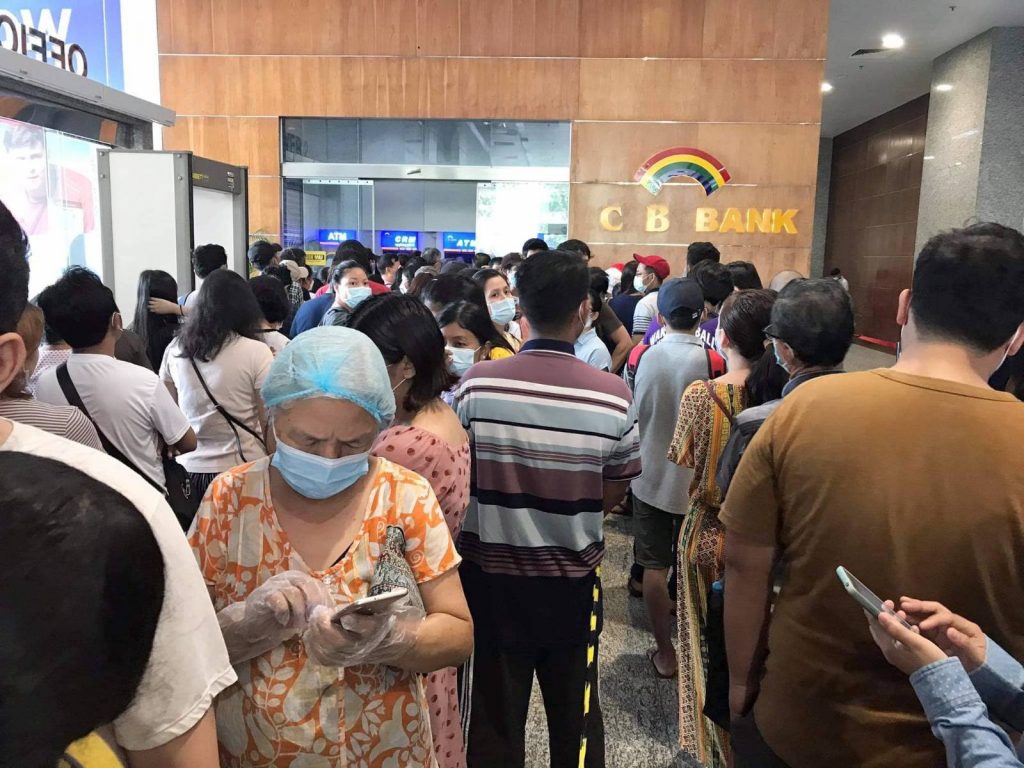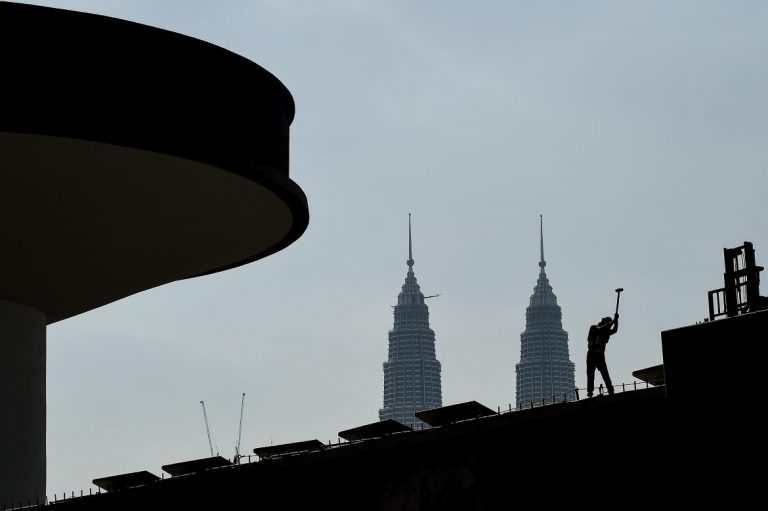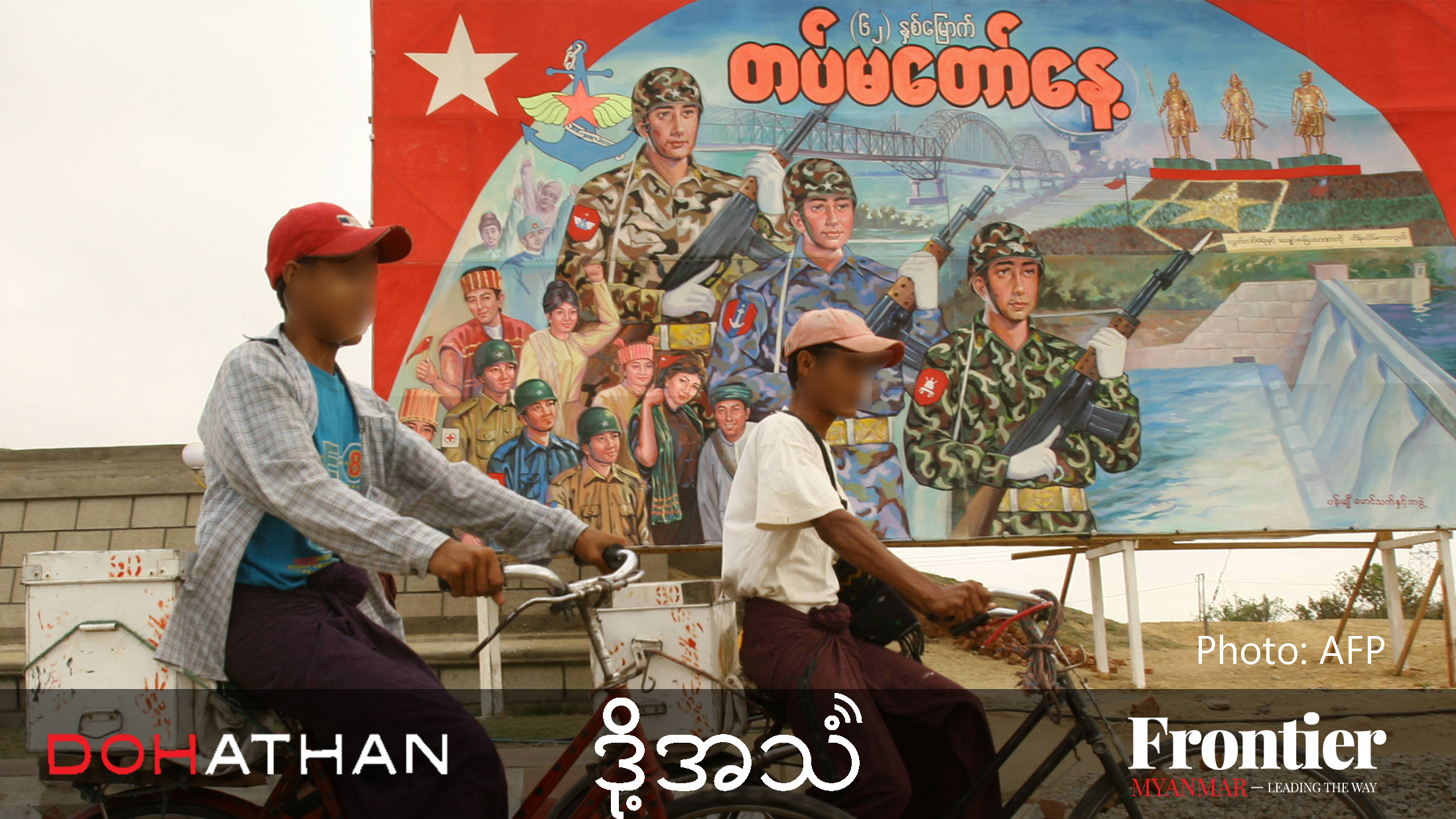Customers are flooding branches and ATMs in an effort to withdraw funds, but with cash in short supply, the steady reopening of branches is only putting more pressure on struggling private banks.
By FRONTIER
For Ko Thiha, Myanmar New Year began with a message from his bosses at KBZ Bank. Within three days all staff would have to inform their manager whether they would resume work, it said, and those who hadn’t returned by April 29 could either resign or face the sack.
Rank-and-file workers like Thiha began joining the Civil Disobedience Movement from February 8, forcing almost 2,000 private bank branches to close and making international payments, withdrawals and interbank transfers all but impossible.
The shutdown has had a huge impact on the broader economy, affecting everything from trade to payroll, and left many businesses and individuals short of cash. The branch closures have also been a visible expression of grassroots opposition to the February 1 coup, undermining the regime’s legitimacy and authority.
Although Thiha didn’t want to abandon CDM, he also didn’t want to lose his job amid a tanking economy. After weighing it up for a few days, he decided to get back to work.
“I have a loan from a microfinance company that I need to repay and a family to support – a wife and a five-year-old daughter,” he said. “It wouldn’t be easy for me to get another job, particularly as I’d have to change my career.”
There were just a handful of staff present when he turned up at his branch on April 20, but the number grew each day; by the April 29 deadline, about 80 percent had returned, although they were not yet wearing their KBZ uniforms.
It’s a scene being repeated around the country, as tens of thousands of striking bank workers slowly get back to work.
Six weeks ago, KBZ – the country’s largest bank – had just five open branches in Yangon ; today, there are 25, and almost half of its 500 branches nationally have opened, according to its website. Other large and medium banks, including AYA, CB and Yoma, are also recalling their staff and reopening rapidly.
The banks are responding to pressure from the regime and the Central Bank of Myanmar, whose leadership was replaced days after the coup, including warnings of possible nationalisation or forced asset transfers if they don’t reopen branches.
Rationing cash
Threats of termination have coerced CDM participants in the private banking sector back to work, but they’ve also revealed a bigger and more fundamental problem: cash is only moving one way – out the door.
The more branches that reopen, the more pressure is put on banks’ cash reserves. As a result, most branches that are “open” are servicing a tiny number of customers who have to queue for hours for the chance to withdraw relatively small sums.
Banks are doing what they can to limit the amount of cash that customers can access. Although the Central Bank has set ATM withdrawal limits at K500,000 (US$320) a day, most banks are permitting just K200,000 a day or less from the machines. Similarly, the regulator has set a weekly withdrawal cap of K2 million for individuals, but most customers who manage to get into a branch can only take out K1 million.
At Thiha’s branch in Yangon the in-person withdrawal limit is just K500,000 and they are serving only 20 customers a day, using a token system. All of the branch’s tokens for May and June have already been distributed, he said.
“Many of our KBZ branches have reopened since April 20, but you wouldn’t necessarily know it – most of them still look closed,” Thiha told Frontier.
Banks have also been rationing cash in other ways, such as by not fully stocking their ATMs, or restocking only a limited number.
Even those that are fully restocking ATMs are finding the cash disappears within hours. “The problem is that the faster you refill the ATMs, the faster the cash disappears – the challenge is between providing services and keeping cash,” said one executive from a mid-sized bank.
“We also have quite a lot of branches open now, but of course transactions within each branch are just a fraction of what they used to be.”
Long lines
Making it hard to withdraw money has so far helped to prevent a bank run, but it has also sapped confidence in an already shaky banking system and forced customers to spend hours lining up for relatively small amounts of cash.
This was particularly evident when businesses paid salaries at the end of April. Because of the shortage of physical cash, most paid through bank transfers, and workers all over the country were forced to queue in long lines at ATMs and branches to access their pay.
On April 29, Ma Moe Zin Mar Oo began lining up at the KBZ branch at Mawlamyine’s Ocean Supercentre at around 8am, taking the place of her sister, who had arrived in the darkness at 4:30am. “Most people do that – someone gets there early and then later someone comes and swaps with them. Otherwise, you’ll be standing there for many hours,” she told Frontier.
Moe Zin Mar Oo had been there about three hours when an argument suddenly erupted. A man had come to replace his wife in the line and another customer mistakenly thought he was cutting in; the orderly queue quickly transformed into a chaotic mass of people as others tried to resolve the dispute. Four police assigned to provide security watched on but made no move to intervene.
After a heated discussion, order was finally restored. As the frustrated customers once again got into line, a man joked that “all of the problems are because of Ma Ah La” – a derogatory reference to junta leader Senior General Min Aung Hlaing. Most readily agreed, Moe Zin Mar Oo said. “They said things like, ‘Yeah, they are idiots’ and ‘Police and soldiers are military dogs’,” she recalled.
Without warning, one of the officers fired into the air and ordered them to be quiet. “The officer threatened to shoot them if they continued making noise,” she said. “We just went back to waiting to get our money.”
For now, Thiha from KBZ said most customers are keeping relatively calm, but he anticipates that could quickly change if the current restrictions on withdrawals aren’t relaxed soon. “We’re the ones who have to deal with customers, so we’re really worried about having problems in the future,” he said.
Some of the shortages are due to technical problems, Thiha said. With branches limiting withdrawals, customers are now more reliant on ATMs. But many machines can only process K5,000 notes, he said, while the Central Bank is mostly providing K1,000 and K10,000 notes.
The mobile internet shutdown since mid-March may also have exacerbated the situation, because money is stuck in mobile wallets like WavePay and KBZ Pay.
But the big issue is simply lack of cash. “At the moment, we’re just reliant on what cash we can take out from the Central Bank, because we aren’t getting any money from customers. The only thing customers are doing is withdrawing cash,” Thiha said. “But my manager told me the Central Bank just can’t provide the cash we need.”
New money and old money
In an effort to get some money back into the banking system, the Central Bank announced in late April that new accounts opened from May 3 would not be subject to existing withdrawal limits.
The move was quickly panned by observers, who pointed out that it would be an administrative nightmare for banks and could potentially be circumvented by transferring money into the new account electronically or by cheque.
One banker described it as “illogical”, while another said it would only make the situation worse.
“They thought they could trick people into depositing money by making this offer, but people won’t do it. It just made people even more aware of the cash shortages, so they will withdraw even more,” he said.
The executive from the mid-sized bank said while the Central Bank had started providing more cash since the end of Thingyan, it was far below what’s needed. Until they can access more, banks will have to continue tightly capping withdrawals.
“It’s all based on how much the CBM provides us. We have a lot of money in the CBM and the moment they let access more we can give our customers more,” he said.
But in an interview with Frontier last month, deputy governor U Win Thaw denied there was any shortage.
“We are distributing banknotes regularly,” he said. “We provide the amount of money they need to be able to operate well.”
On March 31, a German company that since the 1970s has supplied the raw materials used in Myanmar’s banknotes announced it was suspending deliveries to Myanmar’s state-owned Security Print Works “with immediate effect”. Giesecke and Devrient said it took the decision because of the junta’s crackdown on protesters, and that it had already restricted its supply of raw materials, supplies and system components for the production of banknotes in previous weeks.
Asked whether this had disrupted banknote supply, Win Thaw insisted it was “not a big problem”. “We have a plan B. We can get raw materials from other suppliers,” he said. “The printing of banknotes has continued as usual since February 1.”
Crisis of confidence
While banknote printing may be at normal levels, demand for cash is not. The February 1 coup that toppled the National League for Democracy government has prompted spooked and angry depositors across the country to try and pull their money from banks, either to keep it in cash or change it into assets perceived as safer, such as gold or dollars.
At the same time, businesses and individuals still need money to cover normal expenses, but withdrawal caps and cash rationing have made it extremely difficult to get the cash they need.
Banking crises are often sparked by concern about the financial health of banks. The current problems, though, stem from a political crisis that has sapped confidence in the future of the entire country.
Some observers warn that simply pumping cash into the system may not work, because it won’t address the root cause of the crisis: a lack of faith in the military to run the country, and anger at the way it has seized power.
“Yes, the CBM hasn’t been able to provide sufficient cash in a timely manner,” said one former banker. “But you do the math – the only thing people are doing is withdrawing. Sooner or later, banks will run into a liquidity problem. The CBM might inject cash in order to survive, but the question is how much and for how long.”
“The military has messed up the entire financial system … People simply don’t trust them anymore.”
Another banking industry source agreed, saying, “The core issue is around trust in the authorities … When there’s no trust, everyone just wants to hold cash.”







